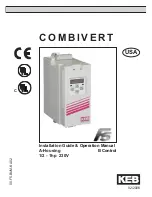
12
Installation and Connection
3.3.3 Line connection terminal X1.A
DC-connection 230 V-class
250...370 V DC
For branch circuit protection use fuses rated
for DC voltage. (Bussmann type FWP)
Line connection
230 V 3-phase
Line connection
230 V 1-phase
PE
L1
N/L2
L3
++
--
����
��
��
���
���
���
��
����
��
��
����
��
��
��
���
���
���
��
����
��
��
����
�
�
���
���
���
��
����
��
��
Terminal strip X1A
Provides connections for:
• 230 V AC / 1-phase (L1/L2)
• 230 V AC / 3-phase (L1, L2, L3)
• DC-Supply 250...370 V DC (++, --)
• Always note the rated voltage, select the appropriate over current protection devices, select
a disconnect device, and select the proper wire size before begining the wiring process. Wire
the COMBIVERT F5 according to NEC Class 1 requirements.
• Always use UL listed or CSA approved copper wire with a minimum temperature rating of
75°C. The wire gauge listed in the tables in section 2.3 is based on the maximum fuse rating,
copper wire and a 75°C insulation rating (THHW or equivilant). If a lower level of overcurrent
protection is used, it may be possible to reduce the size of the wire. Use 300V rated wire for
230V systems .
• A disconnect switch or contactor shall be provided as a means of turning off the supply voltage.
Repetitive cycling on and off of the supply votlage more than once every 5 minutes can lead
to damge of the unit.
• Class CC (Bussmann type LP-CC or equivilant) fuses or a circuit breaker with type D trip
characteristic must be used to provide branch circuit protection of the COMBIVERT F5. The
voltage rating of the fuse or circuit breaker shall be at least 250V for 230V units. See table in
section 2.3 for over current protection amperage ratings.
• Power connection must be installed as indicated on the previous page. Always be sure to
double check power connections for tightness.
• For installation requiring line side ground fault protection (GFI) consult KEB.
• Line chokes can be used to reduce harmonics, conducted high frequency noise, and can
extend the lifetime of the unit. Consult KEB for more information.













































